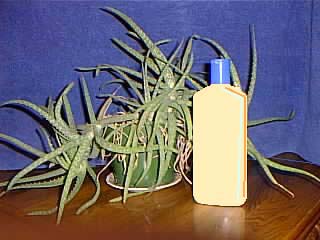Pharmaceuticals and "Functional Foods"
Introduction
Plants have always been an important, and for a long time, the only source of medicines. Still today, a big part of the pharmaceutical market comprises natural products obtained from plants or drugs obtained from plant compounds. Even Aspirin, the most widely-used pharmaceutical, was synthesized from salicylic acid found in meadowsweet. Other examples of drugs obtained from plants are atropine, codene, morphine, reserpine and vinblastine.
Below: the smallpox vaccine was originally obtained from cows.
 Animals in pharmaceutical and medical advancements
Animals in pharmaceutical and medical advancements
Apart from plants, animals have played and are still playing an important role in the biomedical world. In the 19th century, cows were the source of the first smallpox vaccine and, in the 1920s, pigs provided insulin for diabetics. More recently, other drugs have been extracted from these animals, including heparin, steroids, and medicine to treat parathyroid deficiencies. Anesthetics, anticoagulants, blood transfusion, corneal transplants, diphtheria vaccine, drugs for asthma, drugs for high blood pressure, drugs to control transplant rejection, gene therapy for inherited diseases, heart lung machine for open heart surgery, heart transplants, the hib meningitis vaccine, kidney dialysis, kidney transplants, polio vaccine, replacement heart valves, treatments for leukemia and whooping cough vaccine are all other medical advancements that would not have been possible without the help of animals.
Now, investigators are using transgenic animals for medical purposes. With increasing concern over contamination from the human blood supply, animals can provide ideal bioreactors that produce physiologically active human proteins. The authors demonstrate the utility of transgenic animals in producing and secreting the anti-coagulant protein, human Protein C, in milk of mice and pigs. With the availability of increasing numbers of sequences for proteins with human therapeutic value underlies the importance of this technique for development of protein pharmaceuticals. (Fuller, 1996)
Below: aloe plant and product made with aloe vera.
Who has never heard about ginseng, ginkgo, garlic or aloes? In the
western world, the population is aging and is more worried about
health issues. Hence, a fresh upsurge of interest has been observed
in "natural" ways to take care of health. "Functional foods", also
referred to as food supplements for medical use, or nutraceutic products,
are growing quickly in demand.
In fact, the term "functional foods" refers to any food or food ingredient
that gives a beneficial physiological effect likely to prevent and/or
to treat illness and promote better health. In Canada, regulations
prohibit the use of health claims to promote functional foods. This
means that it is not permitted to say that, for example, garlic helps
prevent colds and flu. It is actually the main restriction in the marketing of these products.
Regulations are sometimes more flexible outside Canada. In the United
States, the laws allow eight types of demonstrated claims for food
and their affect on certain illnesses, such as calcium with osteoporosis,
fat with cancer, saturated fats with cholesterol and heart diseases,
fibers contained in cereals, fruits and vegetables with cancer, sodium
(salt) with high blood pressure, fruits and vegetables with cancer
and finally folic acid with anomaly of the reural tube. The European
Union (EU) does not allow the marketing of functional food claims,
but Japan, since 1991, is the only countries to allow the use of
health claims in the marketing of functional foods (FOSHU foods:
Food for Specific Health Use.)
According to the study "Nutraceutic and functional foods: a preliminary
inquiry into their potential in Canada," conducted for Agriculture
and Agri-food Canada in 1995, at least 65 functional foods are prepared
and marketed by Canadian businesses, such as:
(Centre québécois de valorisation des biomasses et des biotechnologies, 1997)
Functional foods
